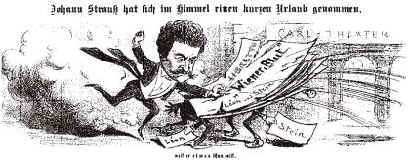
Viennese Blood
|
Wiener BlutDie Musik zur komische Operette (Op. 973) in drei Akten stammt von Johann Strauss Sohn und wurde ursprünglich nicht für diese Operette komponiert, das Libretto von Victor Léon und Leo Stein. Kapellmeister Adolf Müller jun. arrangierte die Musik aus verschiedenen Werken, die Uraufführung: fand am 26.Oktober 1899 im wiener Carl-Theater statt, nachdem die Aufführung dem Theater an der Wien zu teuer erschien und Direktor Jauner vom Carltheater einen kommerziellen Rettungsanker vor dem drohenden Konkurs suchte. Der Floh, Ausgabe 45 berichtete 1899: ".... Mit einem flotten Wäschermädelball schließt die neue Operette, die sich, was Musik und Ausstattung anbetrifft, allerdings gewaschen hat. Ob der tüchtige alte Jauner der Wiener Operette auf die Beine verhelfen wird, können wir nicht wissen; was wir jedoch behaupten können, ist, daß er eine Operette auf schöne Füße zu stellen vermag.". Erst 1905 stellte sich der kommerzielle Erfolg ein. Die Operette dreht sich um Liebe und Gspusi ("Gspaß" und "Gspusi" kommt aus dem italienischen, "spassarsi" heißt sich belustigen, "sposa/sposo" die Braut, Bräutigam). Die Wienerin Gabriele heiratet den Gesandten eines thüringischen Kleinstaates, Balduin Graf Zedlau, der sie jedoch langweilt, da ihm etwas entscheidendes fehlt: das wiener Blut. Die ViennaCC-Version beginnt mit einer verträumten Mundharmonika zur Einstimmung, bevor die Heurigen-Kombo losspielt.
Karikatur, in "Kikeriki", 12. 11. 1899, die Johann Strauß vom Himmel herabfahrend zeigt, entrüstet über das von den Librettisten Viktor Léon und Leo Stein verfaßte Libretto. |

